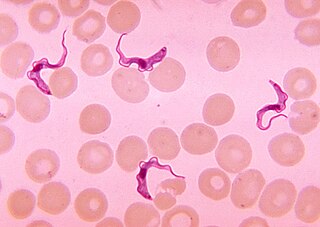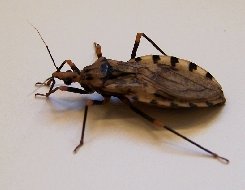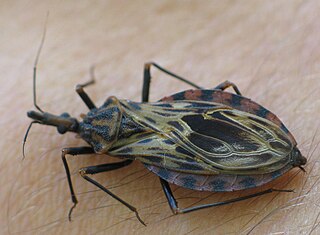
Chagas disease, also known as American trypanosomiasis, is a tropical parasitic disease caused by Trypanosoma cruzi. It is spread mostly by insects in the subfamily Triatominae, known as "kissing bugs". The symptoms change over the course of the infection. In the early stage, symptoms are typically either not present or mild, and may include fever, swollen lymph nodes, headaches, or swelling at the site of the bite. After four to eight weeks, untreated individuals enter the chronic phase of disease, which in most cases does not result in further symptoms. Up to 45% of people with chronic infections develop heart disease 10–30 years after the initial illness, which can lead to heart failure. Digestive complications, including an enlarged esophagus or an enlarged colon, may also occur in up to 21% of people, and up to 10% of people may experience nerve damage.

The Reduviidae is a large cosmopolitan family of the suborder Heteroptera of the order Hemiptera. Among the Hemiptera and together with the Nabidae almost all species are terrestrial ambush predators; most other predatory Hemiptera are aquatic. The main examples of non-predatory Reduviidae are some blood-sucking ectoparasites in the subfamily Triatominae, with a few species from South America noted for their ability to transmit Chagas disease. Though spectacular exceptions are known, most members of the family are fairly easily recognizable; they have a relatively narrow neck, sturdy build, and formidable curved proboscis. Large specimens should be handled with caution, if at all, because they sometimes defend themselves with a very painful stab from the proboscis.

Trypanosoma is a genus of kinetoplastids, a monophyletic group of unicellular parasitic flagellate protozoa. Trypanosoma is part of the phylum Euglenozoa. The name is derived from the Greek trypano- (borer) and soma (body) because of their corkscrew-like motion. Most trypanosomes are heteroxenous and most are transmitted via a vector. The majority of species are transmitted by blood-feeding invertebrates, but there are different mechanisms among the varying species. Trypanosoma equiperdum is spread between horses and other equine species by sexual contact. They are generally found in the intestine of their invertebrate host, but normally occupy the bloodstream or an intracellular environment in the vertebrate host.

The members of the Triatominae, a subfamily of the Reduviidae, are also known as conenose bugs, kissing bugs, or vampire bugs. Other local names for them used in the Americas include barbeiros, vinchucas, pitos, chipos and chinches. Most of the 130 or more species of this subfamily feed on vertebrate blood; a very small portion of species feed on invertebrates. They are mainly found and widespread in the Americas, with a few species present in Asia and Africa. These bugs usually share shelter with nesting vertebrates, from which they suck blood. In areas where Chagas disease occurs, all triatomine species are potential vectors of the Chagas disease parasite Trypanosoma cruzi, but only those species that are well adapted to living with humans are considered important vectors. Also, proteins released from their bites have been known to induce anaphylaxis in sensitive and sensitized individuals.
Nitrophorins are hemoproteins found in the saliva of blood-feeding insects. Saliva of the blood-sucking bug Rhodnius prolixus contains at least seven homologous nitrophorins, designated NP1 to NP7 in order of their relative abundance in the glands. As isolated, nitrophorins contain nitric oxide (NO) ligated to the ferric heme iron (Fe3+). Histamine, which is released by the host in response to tissue damage, is another nitrophorin ligand. Nitrophorins transport NO to the feeding site. Dilution, binding of histamine and increase in pH (from pH ~5 in salivary gland to pH ~7.4 in the host tissue) facilitate the release of NO into the tissue where it induces vasodilatation.

Triatoma infestans, commonly called winchuka or vinchuca in Argentina, Bolivia, Uruguay and Chile, barbeiro in Brazil, chipo in Venezuela and also known as "kissing bug" or "barber bug" in English, is a blood-sucking bug and the most important vector of Trypanosoma cruzi which can lead to Chagas disease. It is widespread in the Southern Cone countries of South America. This region has joined the control intervention called Southern Cone Initiative managed by the PAHO.

Rhodnius is a genus of assassin bugs in the subfamily Triatominae, and is an important vector in the spread of Chagas disease. The Rhodnius species were important models for Sir Vincent Wigglesworth's studies of insect physiology, specifically growth and development.

Panstrogylus geniculatus is a blood-sucking sylvatic insect noted as a putative vector of minor importance in the transmission of Trypanosoma cruzi to humans; this is a parasite, which causes Chagas disease. The insect is described as sylvatic; subsisting primarily in humid forests, and is also known to inhabit vertebrate nesting places such as those of the armadillo, and is also involved in enzootic transmission of T. cruzi to those species. It has wide distribution throughout 16 Latin American countries.

Sir Vincent Brian Wigglesworth CBE FRS was a British entomologist who made significant contributions to the field of insect physiology. He established the field in a textbook which was updated in a number of editions.

Trypanosoma cruzi is a species of parasitic euglenoids. Among the protozoa, the trypanosomes characteristically bore tissue in another organism and feed on blood (primarily) and also lymph. This behaviour causes disease or the likelihood of disease that varies with the organism: Chagas disease in humans, dourine and surra in horses, and a brucellosis-like disease in cattle. Parasites need a host body and the haematophagous insect triatomine is the major vector in accord with a mechanism of infection. The triatomine likes the nests of vertebrate animals for shelter, where it bites and sucks blood for food. Individual triatomines infected with protozoa from other contact with animals transmit trypanosomes when the triatomine deposits its faeces on the host's skin surface and then bites. Penetration of the infected faeces is further facilitated by the scratching of the bite area by the human or animal host.

Triatoma nigromaculata is a sylvatic species of insect usually found in hollow trees, in vertebrate nests on trees and occasionally in human dwellings. It usually lives in relatively humid forests at high altitudes on mountain regions and foot hills. As all members of the subfamily Triatominae, T. nigromaculata is a blood-sucking bug and a potential vector of Chagas disease. This species is distributed mainly in Venezuela, but some specimens have also been found in Perú and Colombia (Cauca).

Triatoma brasiliensis is now considered the most important Chagas disease vector in the semiarid areas of northeastern Brazil. T. brasiliensis occurs in 12 Brazilian states, including Maranhão, Piauí, Ceará, Rio Grande do Norte, and Paraíba.

In epidemiology, a disease vector is any living agent that carries and transmits an infectious pathogen such as a parasite or microbe, to another living organism. Agents regarded as vectors are mostly blood-sucking insects such as mosquitoes. The first major discovery of a disease vector came from Ronald Ross in 1897, who discovered the malaria pathogen when he dissected the stomach tissue of a mosquito.
Trypanosoma rangeli is a species of hemoflagellate excavate parasites of the genus Trypanosoma. Although infecting a variety of mammalian species in a wide geographical area in Central and South America, this parasite is considered non-pathogenic to these hosts. T. rangeli is transmitted by bite of infected triatomine bugs of the Reduviidae family, commonly known as barbeiro, winchuka(vinchuca), chinche, pito ou chupão.
Prothoracicotropic hormone (PTTH) was the first insect hormone to be discovered. It was originally described simply as "brain hormone" by early workers such as Stefan Kopeć (1922) and Vincent Wigglesworth (1934), who realized that ligation of the head of immature insects could prevent molting or pupation of the body region excluded from the head if the ligation was performed before a critical age in the lifestage was reached. After a certain point the ligation had no effect and both sections of the insect would molt or pupate. However, implantation of a conspecific brain to a sessile ligated abdomen or an abdomen under diapause would induce molting or pupation. Thus, the brain was originally thought to be the source of the hormone that induces molting in insects.
Rhodnius nasutus is a Chagas disease vector native to the northeast of Brazil. It belongs to the family Reduviidae and subfamily Triatominae, which are commonly known as "kissing bugs" or "assassin bugs". They are considered a highly important species concerning the infectious Chagas disease as they carry the parasite Trypanosoma cruzi, that can be transmitted to the blood of mammals, including humans. This disease is an important issue in Brazil and central America due to the large number of Rhodnius species inhabiting these areas, however in recent efforts to reduce human infection, multiple variations of pesticides have dramatically reduced Triatomine populations. Therefore, the understanding and knowledge of Rhodnius nasutus greatly benefits our efforts in reducing life threatening infections.

Triatoma sanguisuga, also known as the eastern bloodsucking conenose, is an insect of the Triatominae subfamily, known as kissing bugs.

Triatoma gerstaeckeri is an assassin bug in the genus Triatoma. It is an important vector of Trypanosoma cruzi, the causative agent of Chagas disease. The range of T. gerstaeckeri is from the south-western United States to north-eastern Mexico. T. gerstaeckeri goes through three stages during its paurometabolous life cycle: egg, nymphal instars and adult.
Triatoma indictiva is an arthropod in the assassin bug family of Reduviidae, and is an important vector of Trypanosoma cruzi. T. cruzi is the protozoan that causes Chagas Disease, which affects approximately eight million people a year in the western hemisphere alone. Triatoma indictiva is found in Mexico and throughout the southern United States, including Arizona and Texas.

Triatoma sordida is an assassin bug within the genus Triatoma. This species consists of three subspecies. Also referred to as kissing bugs, T.sordida are most well known for their role as a secondary vector of Chagas Disease. Inhabiting warm, dry climates, T.sordida are widely distributed throughout South America, occupying houses, farming structures, and wild habitats. Pest control is currently focused on insecticide application. However, biological controls utilizing fungi appear promising.















